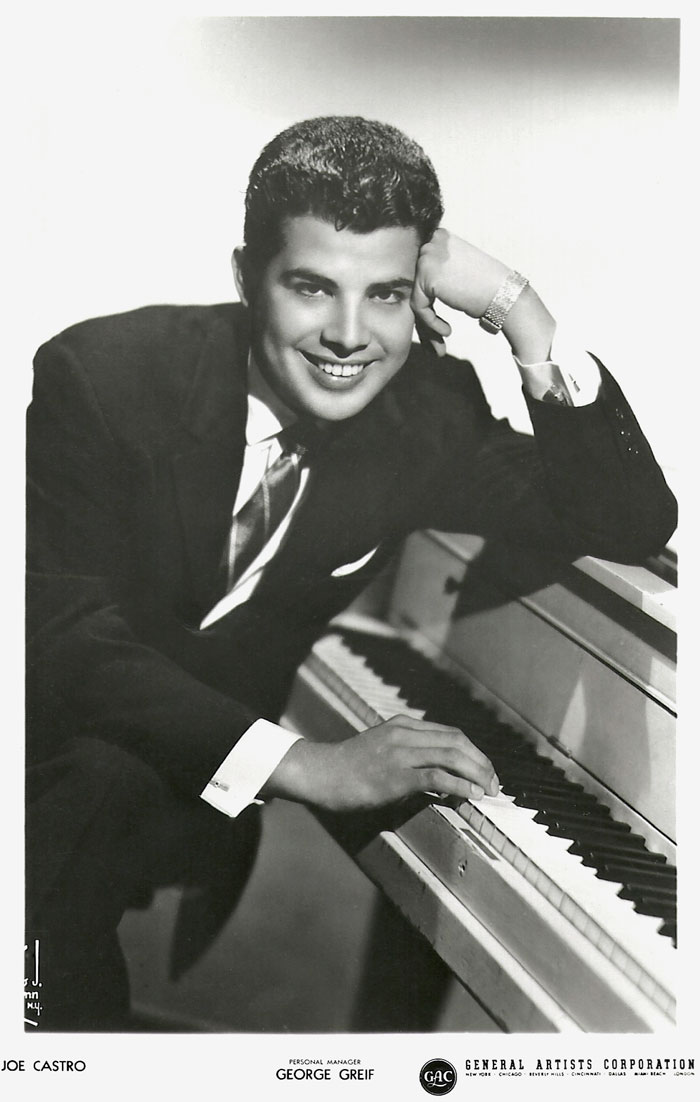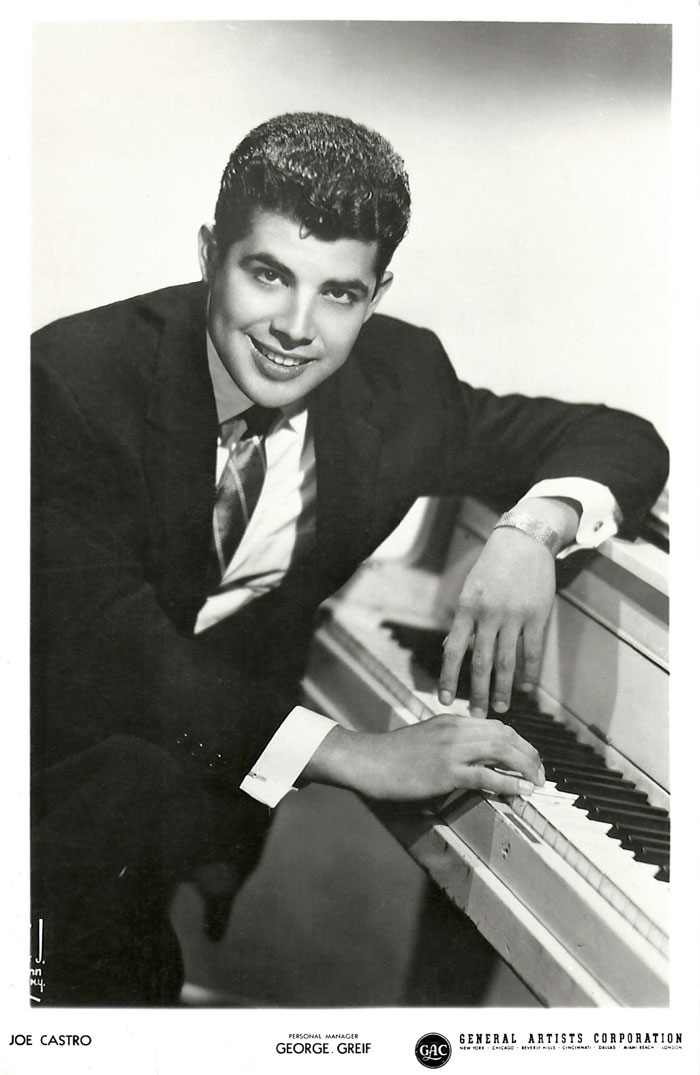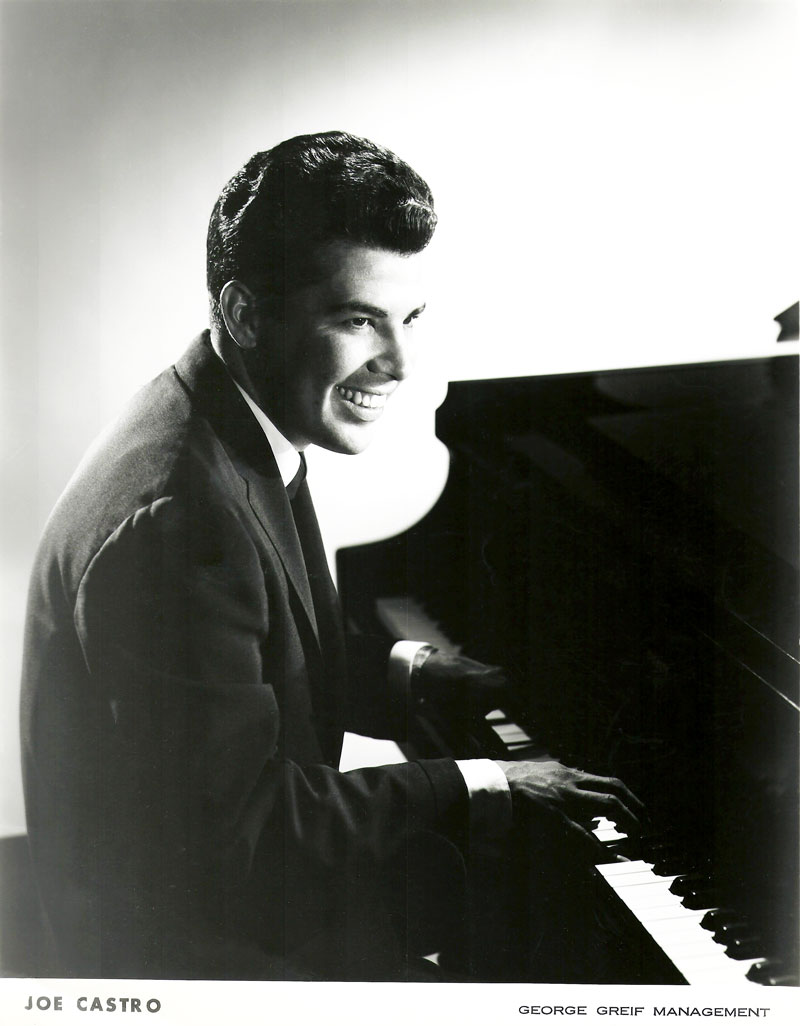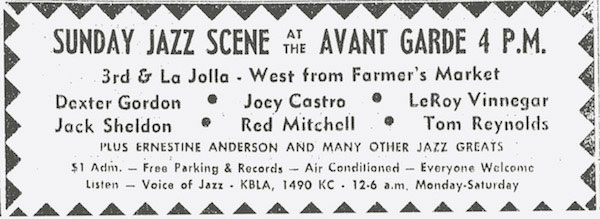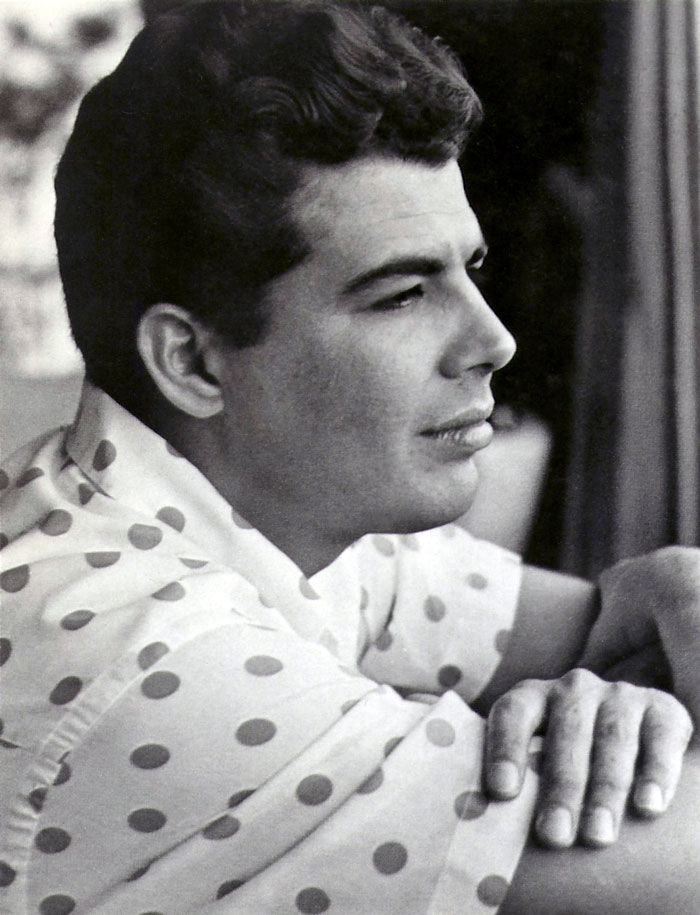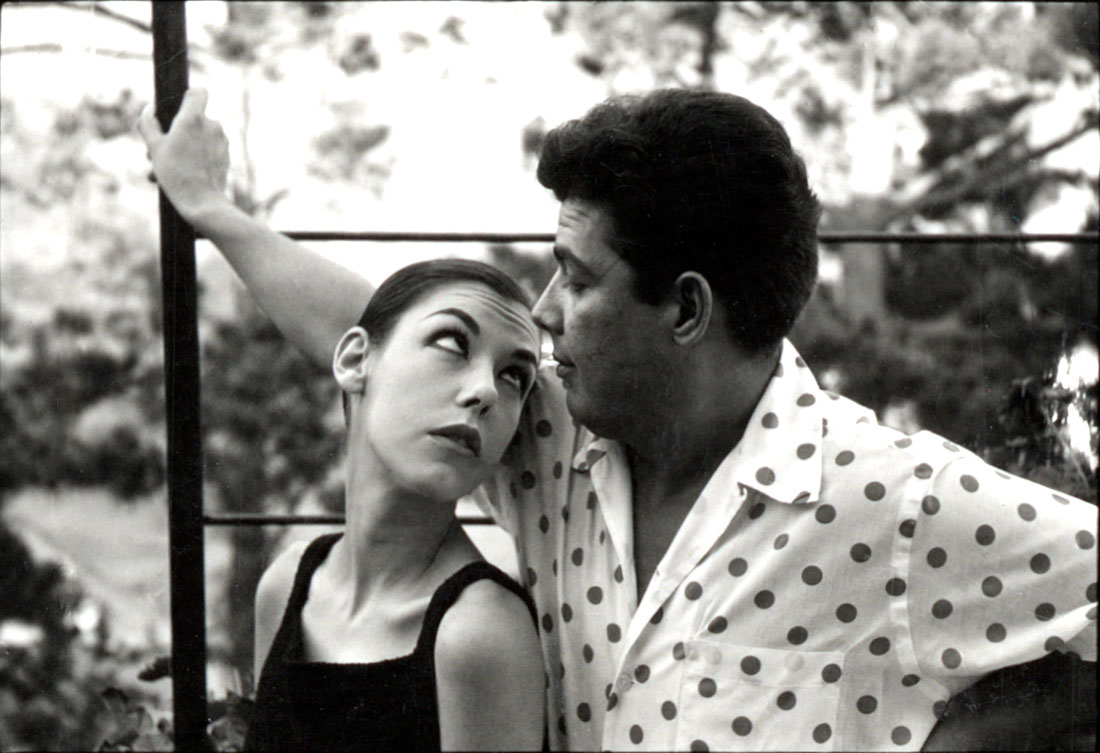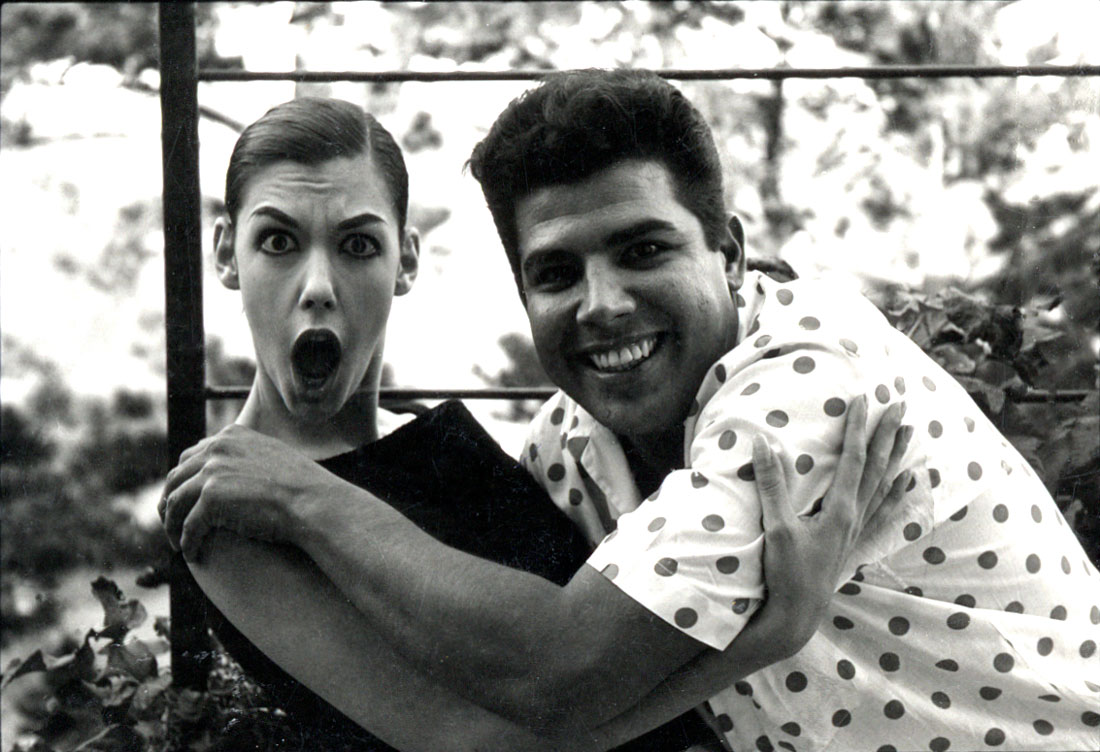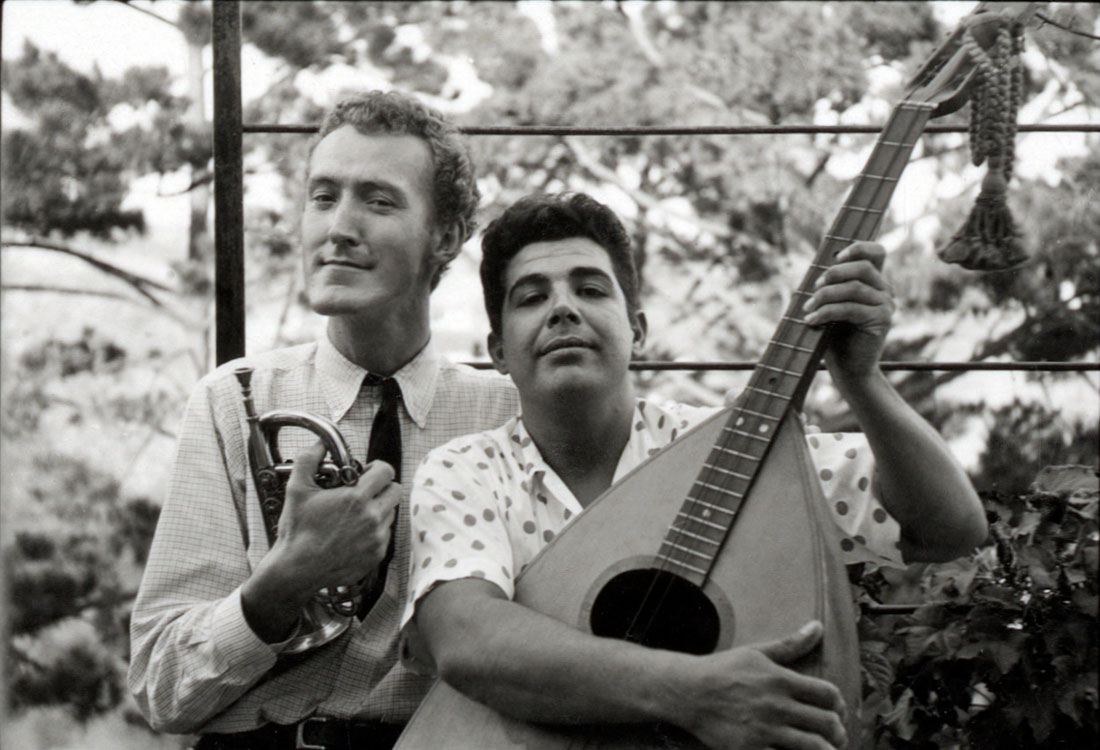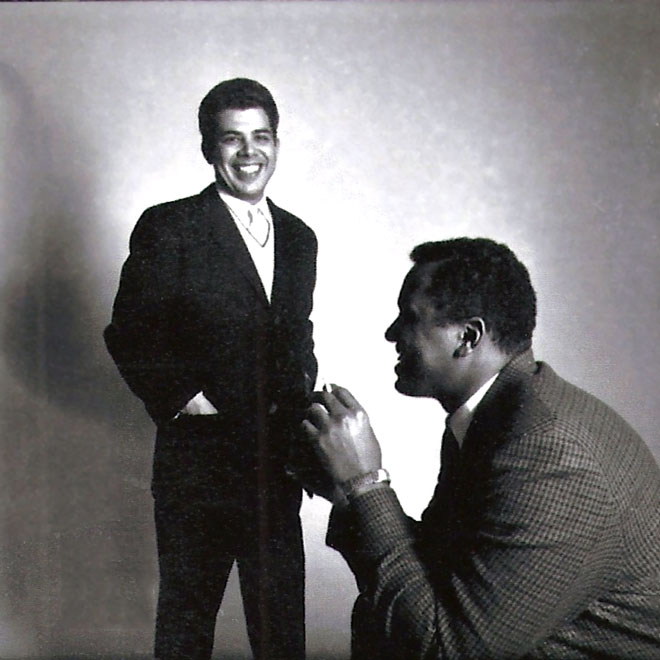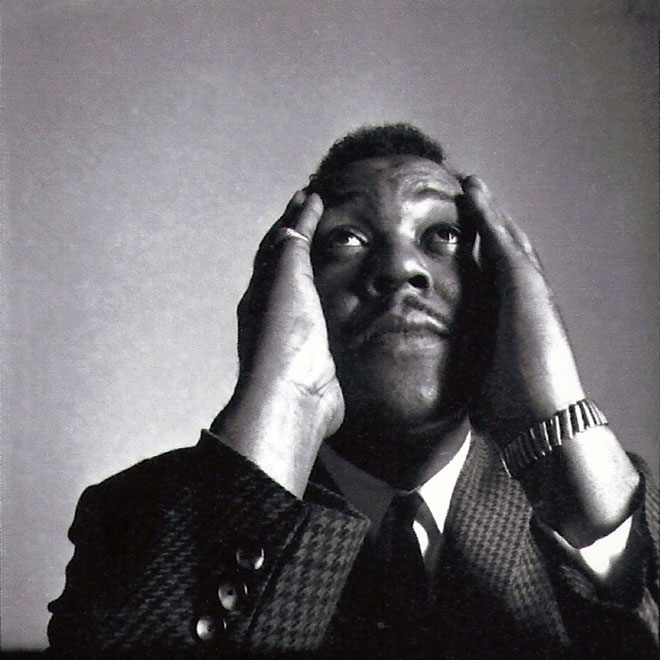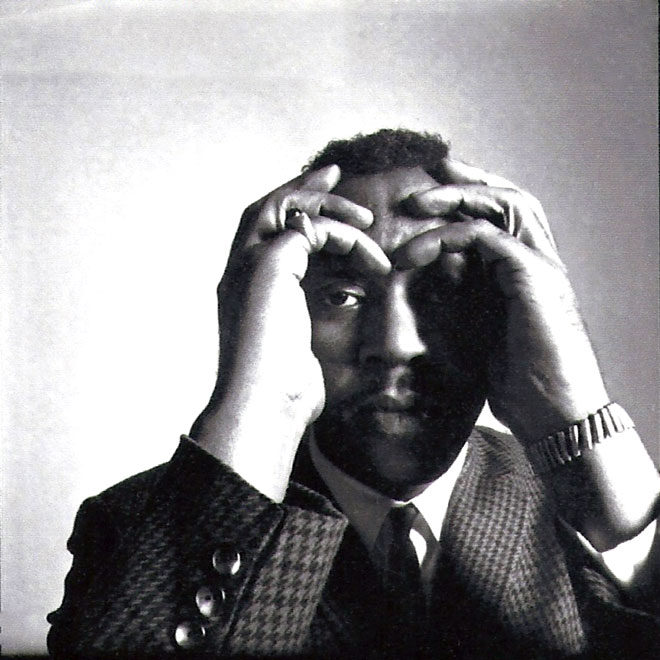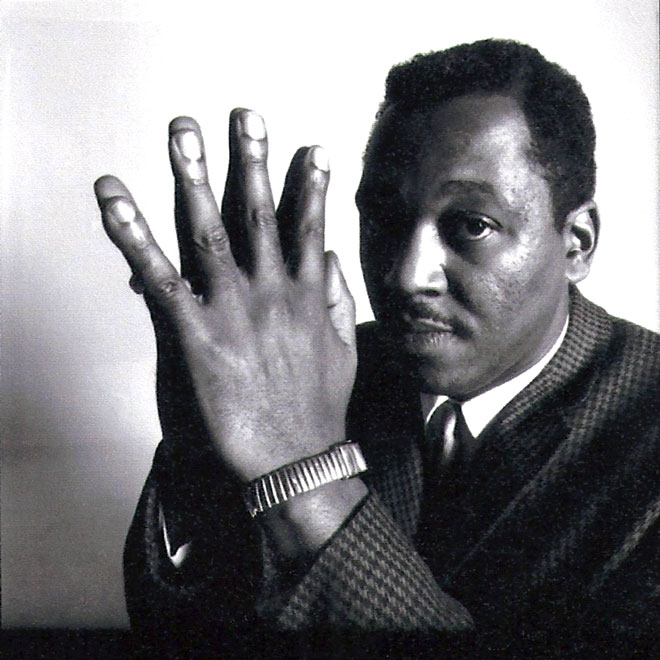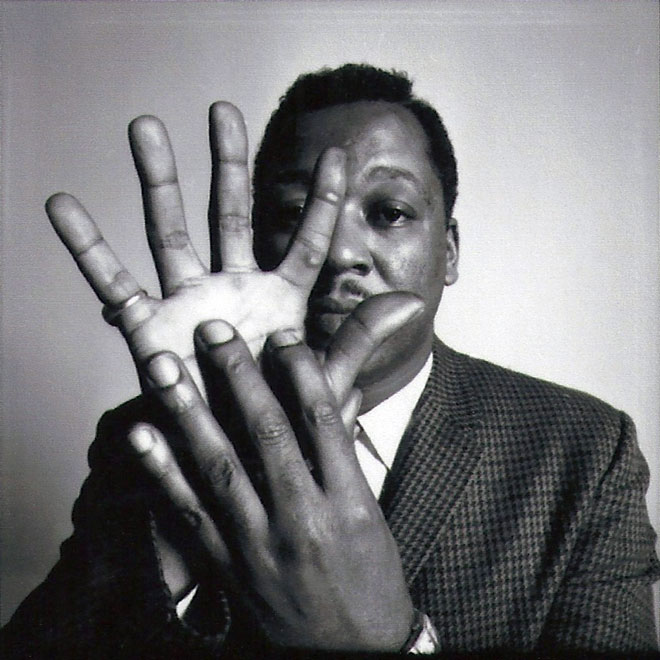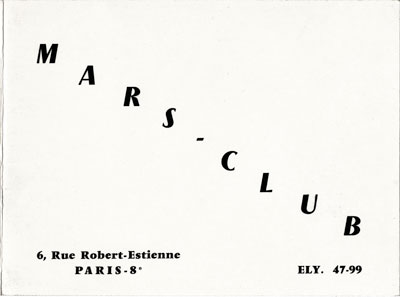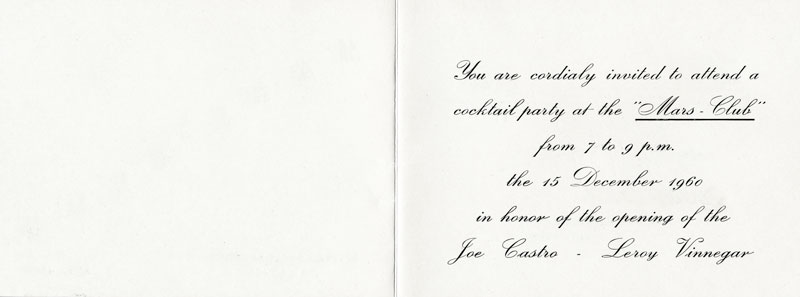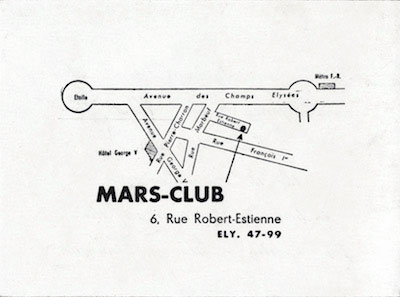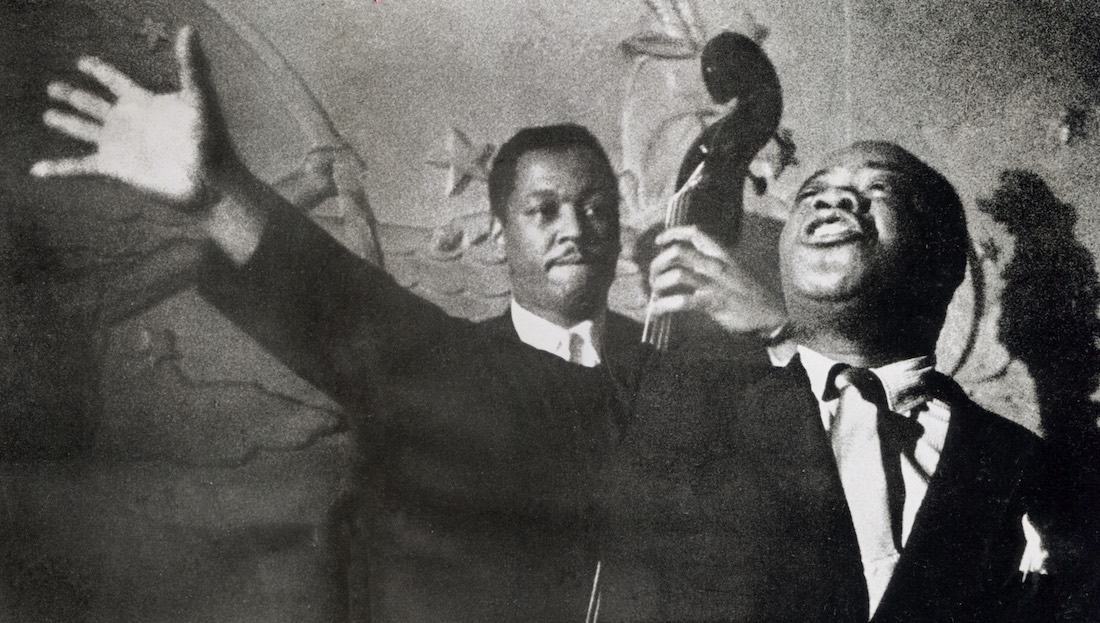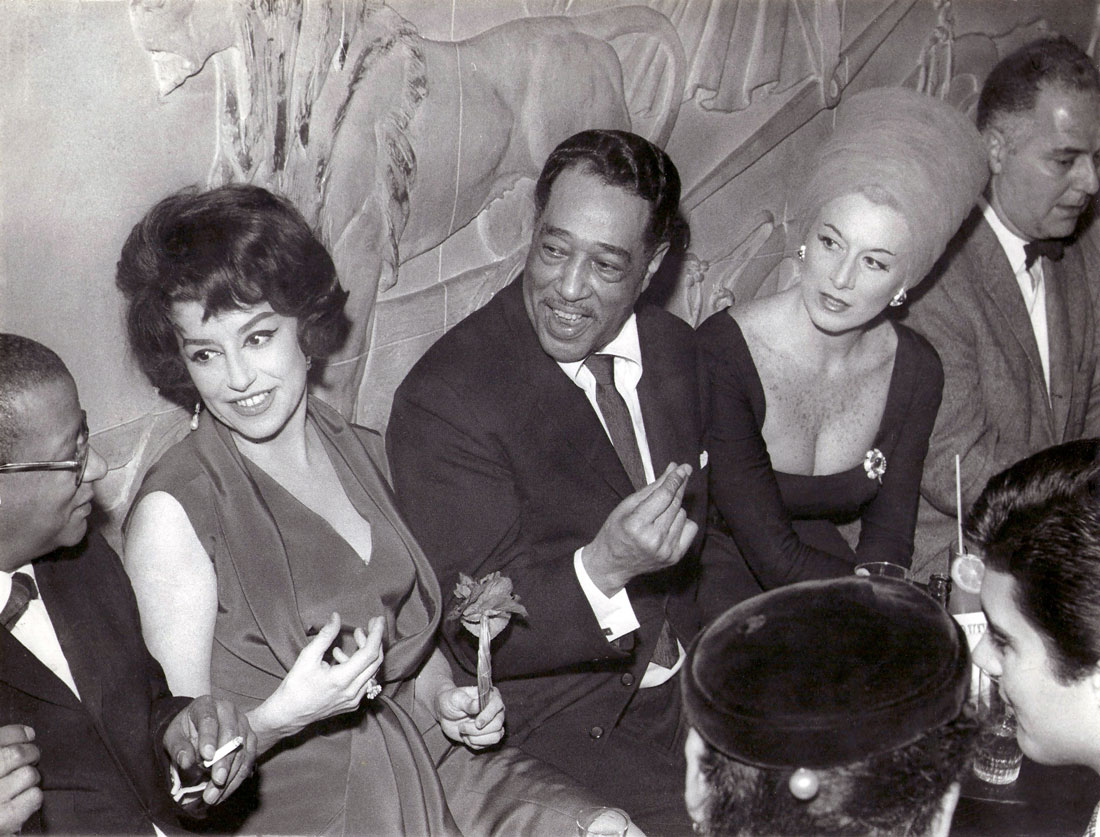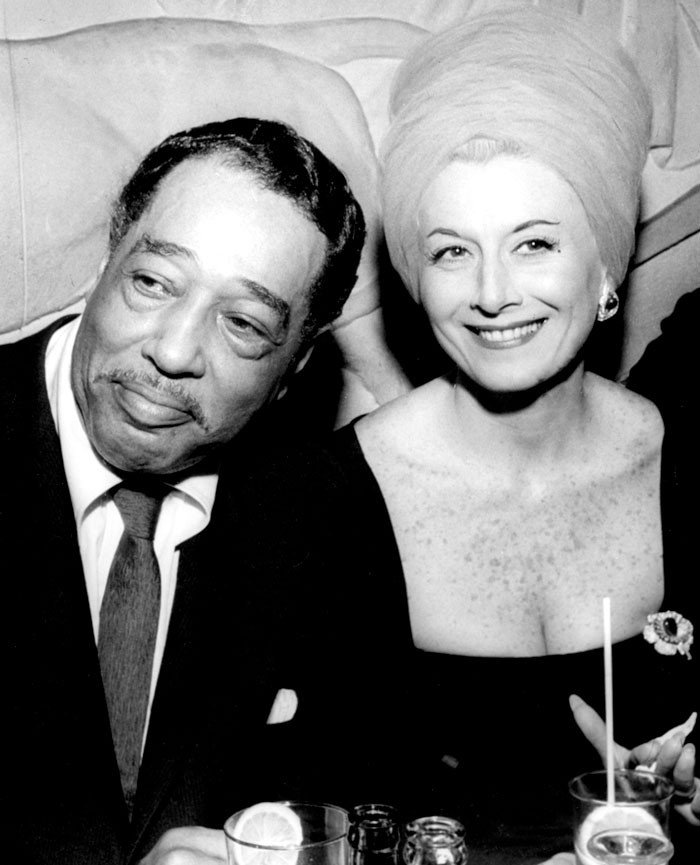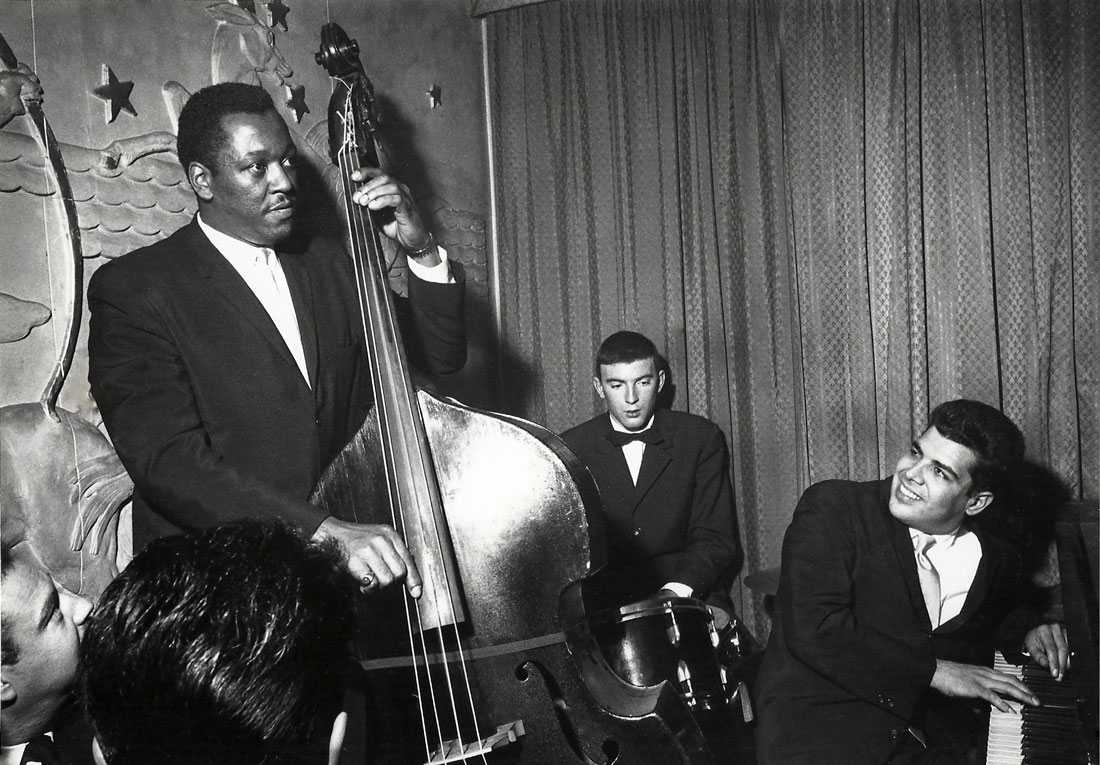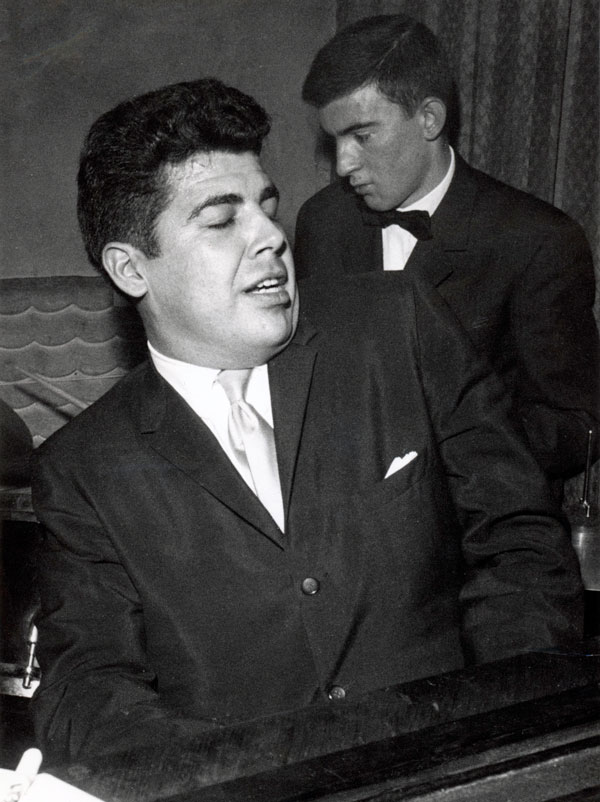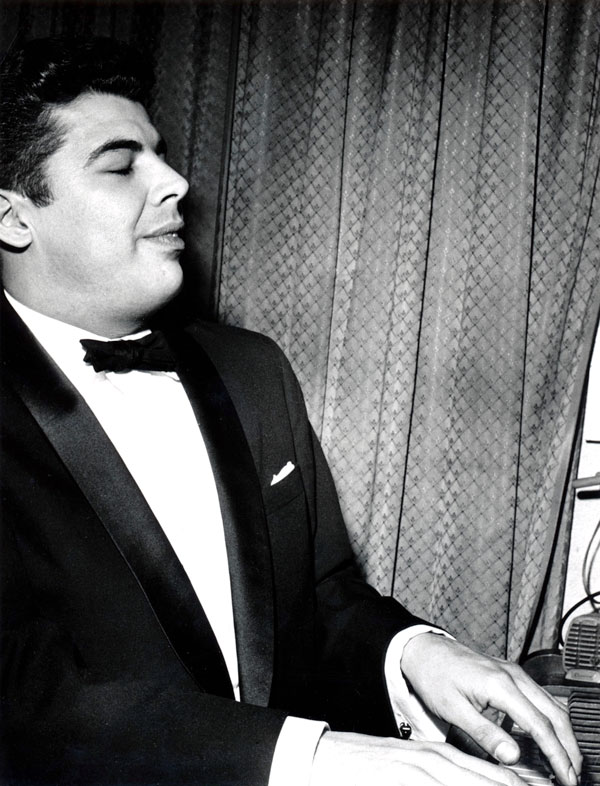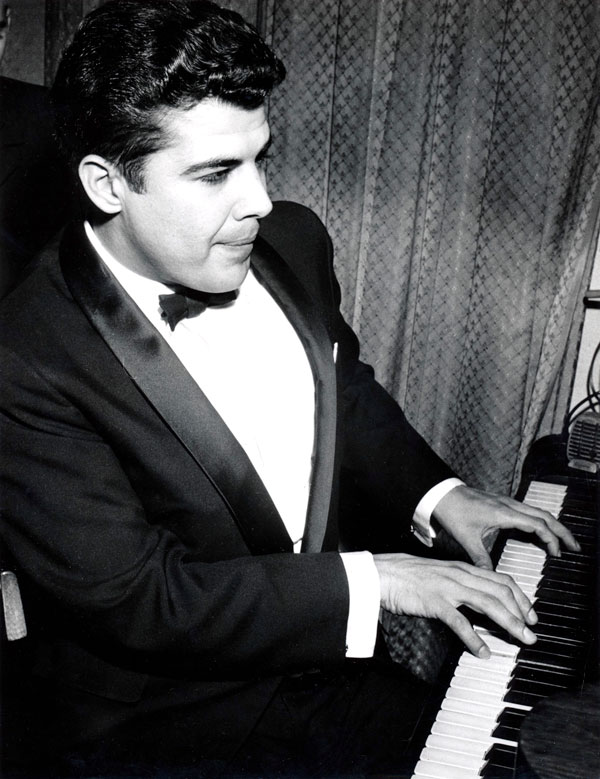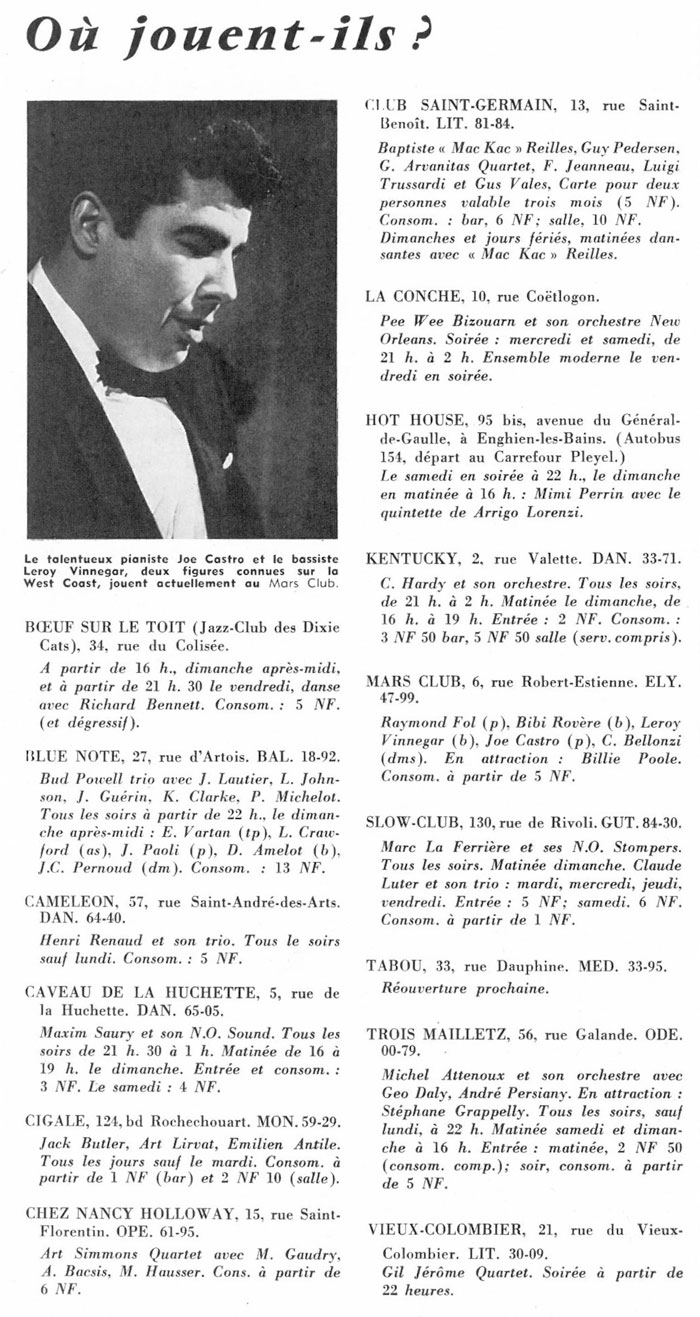Back to Los Angeles,[•] after the Toluca Lake gig, in May, Castro’s Trio featuring San Jose drummer Tommy Reynolds and bassist Fred Dutton[•] began a long stint at Maynard Sloate’s Avant Garde.[•]
Castro:[•] Around that time, too, I started working in Los Angeles with Leroy Vinnegar. I had a drummer, a guy from San Jose, Tommy Reynolds, he played with him. Leroy wasn’t too crazy about him. He was a good friend of mine and he sounded good enough. We had played together at Maynard Sloate's Avant-Garde with some good people, Lenny Bruce was there, Don Adams.... We didn’t have to play for them…. We played on the same bill with Ann Richards, a great singer. [She] worked with me later at the Sands in Las Vegas, Stan Kenton’s wife. I’m saying this because we had started working for Maynard.
Some info and appreciation on the gig:
Hank Grant: Joe Castro Trio, also debuting, draws more than usual attention with carefully rehearsed numbers that find all cuts, holds, swells and fades met with arresting precision by Castro on the ivories, Tommy Reynolds on drums and Fred Dutton on bass.[•]
Variety: The Joe Castro Trio's 20 minutes of excellent swinging rhythm provides a toe-tapping lead-in for the show which, altogether, lasts 80 minutes.[•]
It was probably at this point that the following sessions occurred:
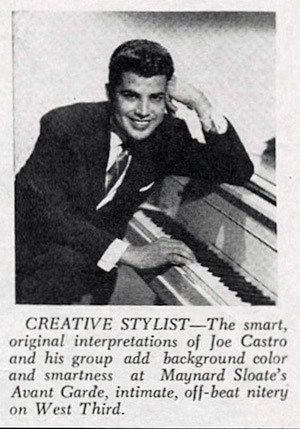
(James Castro Collection)
Musicians recorded at Falcon Lair:
It seems to be after this weekly gig at the Avant Garde that Joe had the Sunday afternoon jam sessions:
Castro: We had jam sessions on Sundays featuring Leroy and myself…. A good drummer Billy Higgins…. We used Jack Sheldon and Dexter Gordon. It was really a romping thing and everything...really played good. We had a good time doing that.
It is likely that during these Sunday jam sessions Joe Castro met Billy Higgins for the first time.
Castro: We [Leroy Vinnegar] were never satisfied with our drummer, until we got Billy Higgins.[•]
Musicians recorded at Falcon Lair:
Various rumors surrounded Castro and his burgeoning career. There were hints that he was going to be cast in a Steven Cullen film entitled Debutante[•] and possibly writing the music for a musical film by Laurence Schwab entitled Dry Wine.[•] Castro was also purportedly signed by Mercury in August for an album of Latin and Italian love songs.[•] None of these seem to have come to pass. Also, rumors of Doris Duke looking for a nightclub to buy,[•] and, as usual, about their relationship.[•]
After the Avant Garde, there were two weeks at the Interlude,[•] with Leroy Vinnegar,[•] probably in trio a setting.

(James Castro Collection)
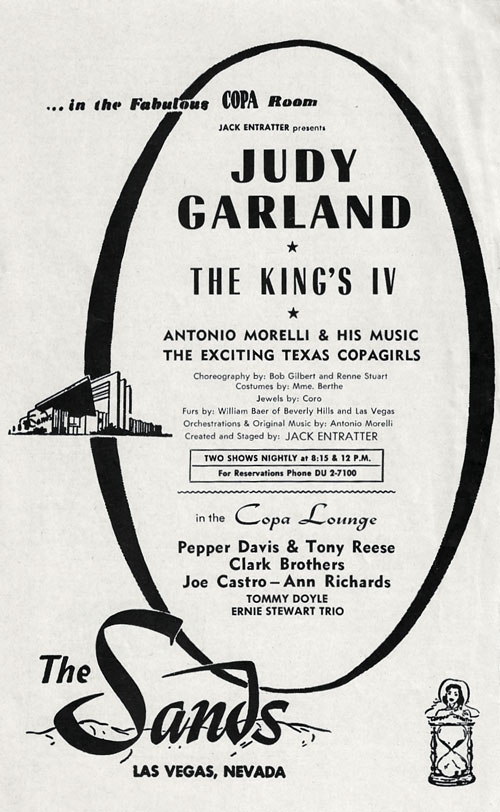
In early September, Castro began a four-week[•] engagement at the Sands Hotel Lounge in Las Vegas. It was Castro’s first time in Vegas. Originally, he intended to bring Leroy Vinnegar as his bassist but due to a segregation policy in Las Vegas,[•] he had to bring Don Payne.[•] There he held an engagement, backing vocalist Ann Richards.
Musicians recorded at Falcon Lair:
During that time, the Leroy Vinnegar Quartet[•] opened at the Black Hawk in San Francisco for an engagement opposite Billie Holiday.[•]
Down Beat: ...Vinnegar's group is currently working S.F.'s Black Hawk opposite Billie Holiday...but in L.A., pianist Joe Castro insists Leroy's joining his trio. Quo vadis, Leroy?[•]
Also in Down Beat: Long-time nitery owner Maynard Sloate shuttered his Avant Garde club, declaring “There's no night club business in L.A. any more.” Besides which, the Mocambo and Ciro's are on the block, also....[•]
Back in LA, while playing with Bob Cooper’s Lighthouse Stars at the famous Lighthouse club in Hermosa Beach (most likely in October), Castro was asked to accompany Cooper’s wife, famed vocalist June Christy, who gained fame as the vocalist for Stan Kenton. The first gigs with Christy were with a college orchestra in Tuscaloosa, Alabama[•] and then with a trio at Porky’s, in Fort Lauderdale, Florida. Both were successful and the two had a great rapport.
Castro: Along then, I’d got a call to go down to be with Lighthouse Stars. Bob Cooper was still at The Lighthouse Hermosa Beach. At that particular time when that happened, his wife June Christy, the jazz singer from Stan Kenton’s days now on her own, needed a pianist to go on some dates. [Cooper asked] would I be interested and could I meet June and see how we would work together. I went over to June's house, over there in Sherman Oaks. She had a little house on the hill with a little pool and all that. She lived there with her husband and Nana, her housekeeper, really nanny for Shay, her little girl. When she travelled somebody would take care of her. Bob worked there, too, in Hollywood studios and different jazz things. So we start playing in the little studio room there. We had a rapport immediately. He said: “Great, can you do it?” I said: “Let’s go.” So my first day with her, I told Doris. She liked June right away. She liked the record Soothe Me that she remembered from Stan Kenton days.... New York days.... So we flew to Tuscaloosa Alabama. There was a big student band. I whipped that sucker into shape. I was excited about it. I had not played her book yet. I was familiar with some things but I just took the lead from what was going there and sort of bullshitted my way through. Got the guys to play. She was amazed. It came out great. It came out really good for what it was. We had a good time. Then we went over to Fort Lauderdale to a place called Porky’s. They had a little black trio.[•] Different kind of job for us. No big band. That worked out really good.... My first job with her. She was delightful....
Back in LA, Castro’s Trio with Leroy Vinnegar and Billy Higgins[•] opened at the Regency[•] on La Cienega, probably on December 4, 1958.
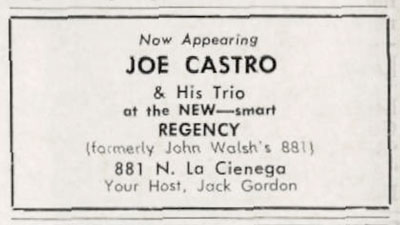
And then the Leroy Vinnegar Quartet featuring Teddy Edwards, Castro, and Billy Higgins appeared on the TV show “Stars of Jazz” which was taped on December 15 and aired December 22, 1958.[•]
Castro: Leroy introduced me to Teddy Edwards when we did the “Stars of Jazz” show for Bobby Troup. Everybody felt good playing together and we just naturally hung out and worked a lot together.
On December 28, 1958,[•] Joe Castro flew to New York to spend the New Year…
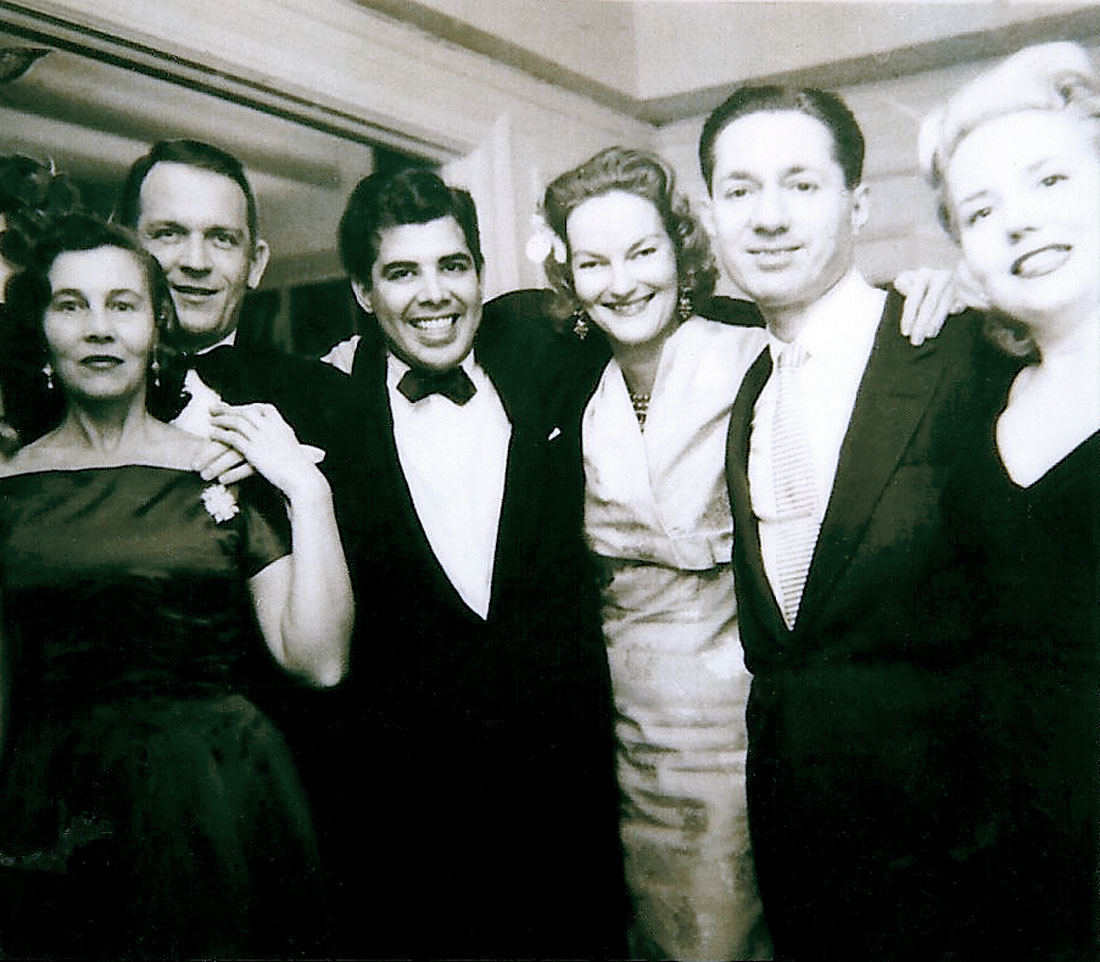
(James Castro Collection)
...but was back January 1, 1959,[•] to start playing with June Christy at the Crescendo club in West Hollywood.[•]
John L. Scott: Another fine singer of the day, June Christy, bows at the Crescendo on the Sunset Strip for a limited engagement. She’s a swinger. Called The Misty Miss C, this vocal artist is, first of all, a perfectionist in styling. Her work has won three awards from Downbeat Magazine as Best Female Vocalist. Miss Christy’s hit discs include Something Cool, Gone for the Day, and The Misty Miss Christy. Her newest Capitol album, June’s Got Rhythm, has just been released and promises to be a big seller. Backing the songstress is the talented piano work of Joe Castro, who will play special arrangements by Pete Rugolo.[•]
The Hollywood Reporter: SRO turnout for June Christy's Friday opener of two-week stand at Gene Norman's bistro.... Melody backing of Joe Castro on the piano, together with three sidemen[•] from the René Touzet sextet, made a great backing for Miss Christy.[•]
Howard Lucraft: June Christy, inspired by the superb backing of pianist Joe Castro, was especially creative at her recently concluded engagement for Gene Norman at the Crescendo on the Sunset Strip....[•]
Lucraft: On the same bill [Crescendo] were June Christy and Lennie Bruce. Christy was backed by bassist Leroy Vinnegar, drummer Billy Higgins and pianist Joe Castro. Inspired by Castro's harmonically inventive, if a trifle busy, piano, Christy was just wonderful--at her sparkling best.[•]
Still jamming, but at the Hillcrest:
Castro: We had the Hillcrest club we used on our day-off, Mondays. We had jam sessions at the Hillcrest club in Los Angeles in the black district. We played with Dexter Gordon, Jack Sheldon, Leroy Vinnegar, Billy Higgins.... We had some nice times with Teddy....[•]
Later that month, Castro would record with Christy and Pete Rugolo for the album June Christy Recalls Those Kenton Days.[•] He was still living and hosting sessions at Falcon’s Lair.
The informal jazz sessions inevitably led to a working ensemble that began as Vinnegar’s group featuring Castro, Teddy Edwards and Billy Higgins. The group’s first appearance was at the Intimé[•] at 5000 S. Western Avenue, in February. This association would prove to be one of the best and most rewarding for Castro.

Musicians recorded at Falcon Lair:
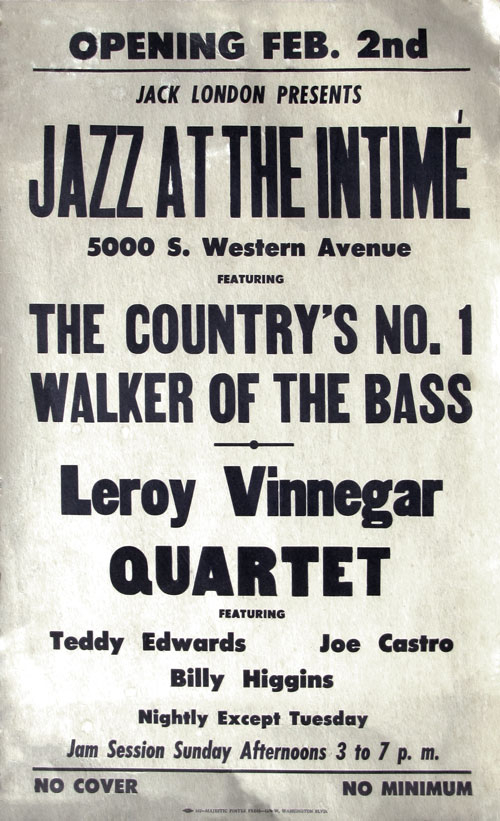
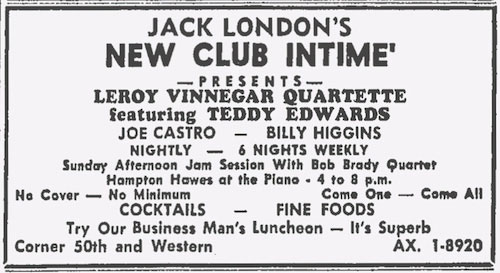
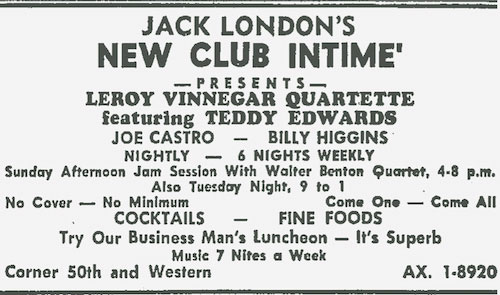
Castro was between Vinnegar’s group and June Christy from late January through March.[•]
At the end of The Intimé run, before and after a concert with Ann Richards at Pasadena for the ’59 Spring Jazz Festival,[•] Joe Castro rehearsed for an engagement at the Sahara Lounge, in Las Vegas,[•] with June Christy.
Castro: We were going to the Lounge...Sahara. I hired Karl Kiffe and Don Prell and we rehearsed up at the Falcon Lair without June, just me and the music. She didn’t need to dance around and I closed at The Intimé…. We drove to Sahara…. We were there for three weeks and Don and I roomed together right there on Sahara Boulevard, a place called the Robertson apartments. It’s not there anymore, right there between on the first block on the left, which is now the Sahara at the end of the Strip.... Then late night with June Christy...all the cab drivers, music lovers, hookers, and all that.... Like when Billie Holiday was there, they all came out. It was great. She enjoyed it.... It was a little stage right behind the bar. You had to go behind the bar to get up to it. It was awkward. The piano was not that great, it was like a little spinet. That’s all they ever used. That’s where I went later with Don Rickles. That’s where Kelly Smith was with Louis Prima and all them. I see [Joe Castro comments on his diary] that Lloyd Pantages had a birthday on the 16th of April, so I see I was there the rest of the month, April ’59. June and I.
Musicians recorded at La Vista, Las Vegas:
Also in April, there was a review for the tape edition of Mood Jazz[•] by Leonard Feather, a great Joe Castro supporter:
Castro is one of the most undervalued pianists in jazz. He swings like Prévin crossed with Silver.... As Dave Brubeck points out, in an eager endorsement that accompanies Gary Kramer’s helpful liner notes, “Here is an extremely talented individual, a fine musician, an excellent pianist and a tasteful performer.”[•]
Back in LA, Joe Castro and June Christy had a gig at the Patio Garden, New Lagoon, in Salt Lake City.[•] Then the Quartet again, first at Jazzville U.S.A., Sunday, May 10, 1959…
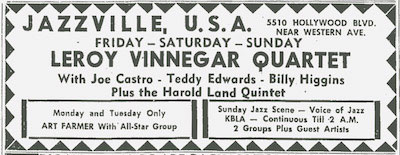
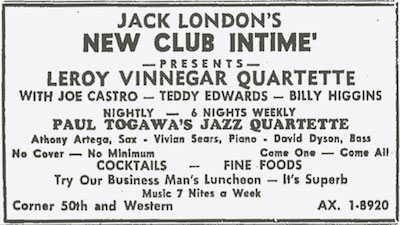
...and then at the Intimé.[•]
Castro then put together a small orchestra for a late May hit with Christy at the Crescendo:[•]
I had a band, a little band. Gene Norman was the booker there. He wanted me to have a little band so I had a band with [reading his diary] Karl Kiffe, Don Prell, because they already knew the music, I had to get some horns, so I got Jack Sheldon, Joe Maini, Modesto Briseño, who was from San Jose and who I met through Allyn Ferguson [also from San Jose] with his poetry and jazz, little group. He [Modesto Briseño] ended up playing even for Benny Goodman. Bobby Burgess on trombone, Lester Robertson, Lennie Niehaus, Jack Montrose.... So...I guess that was the band. We had the day off on Monday.
Working with June Christy at the Crescendo, in San Francisco, and then at The Cloister, Joe Castro was no longer at the Intimé with the quartet, though the advertisement said otherwise…
...though, he may have played occasionally. It is also during that period that he could have met again pianist Paul Bley.[•]
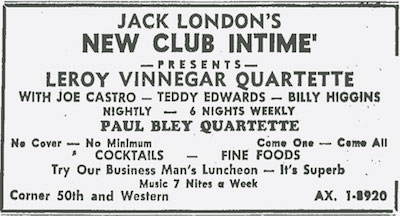

(James Castro Collection)
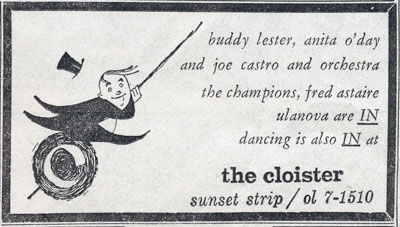
Castro: “I went to San Francisco with June Christy to Fack’s II,[•] that was a nice engagement. I stayed with Vernon Alley at his house....
In June, Castro was recruited to lead an orchestra to back vocalist Anita O’Day for an engagement at The Cloister[•] (formerly Mocambo, which closed June 30) in Los Angeles. He enjoyed his work with O’Day and enjoyed the rehearsals where Vinnegar and O’Day squared off regularly:
(Castro looking at his diary) I see, I made calls about Lennie Niehaus. About the rehearsal. Teddy Edwards was on that, too, because we were going to open up with Anita O’Day. That’s what it was.... I had a rehearsal with Anita O’Day and the band that was a real zinger. She got into it with Leroy immediately. She, you know Anita, acts up, too, but she was singing good and all that kind of stuff.... She’d count off the tempo for Honeysuckle Rose, which she did for sixteen bars. The first were for bass alone. Leroy says, “I know the tempo,’”[imitated Leroy] “I know the tempo.” She used to con you. He was acting up. She was acting up. So they deserved each other.... Cloister was where the old Mocambo was.... A bunch of guys from Chicago who I also worked for later at another place, I'll tell you about later, called PJ's. They were from Chicago. Hip guys.... They took the place of Mocambo. More jazz things in there.
The reception was good:
Scott: Exciting song stylings of Anita O'Day plus zany comedy by Buddy Lester combine to furnish quite an evening at The Cloister, the new night club on Sunset Blvd. Excellent backing by Joe Castro and his orchestra, who play for dancing, is an additional asset to the new show. Miss O'Day gives modern-day jazz a new twist with her fine timing and vocal flutterings up and down the scale. Most of her tunes are oldies but she does amazing things with them, particularly Sweet Georgia Brown and Honeysuckle Rose.[•]
John Tynan: Personnel: Anita O’Day, vocals; Joe Castro band accompanying Joe Castro piano; Mel Moore, Mel Young [?] trumpets; Lester Robertson trombone; Lennie Niehaus alto saxophone; Teddy Edwards tenor saxophone; Modesto Briseño baritone saxophone; Harper Cosby[•] double bass; Nick Martini drums. After an affectionate introduction by Gene Krupa, Miss O’Day whirled into one of the best vocal sets ever to sizzle the Sunset Strip. Smartly garbed in green and sporting white gloves, she presented a well-balanced act that, for all its musical excellence, seemed above the heads of the opening night audience. Anita is, always has been, and probably always will be a jazz singer and consequently was a little too far out for the customers. After launching into an up-tempo Stella by Starlight, she continued with such established O’Day-tunes as You’re the Top and Honeysuckle Rose. Easily the best number of her set in terms of showmanship and audience response, though, was a reprise of her classic Let Me Off Uptown with trumpeter Mel Young filling the spot that used to be Roy Eldridge’s in the Krupa big-band days. Young blew with considerable strength and intelligence and impressed as a new hornman on the way up. Anita’s closer—a wild arrangement of Sweet Georgia Brown which started slowly and gradually rose to an up-tempo romp that had the room rocking—was crystalline evidence that here was one of the greatest singers in jazz. Castro’s band played some good, extroverted jazz for dancing and did a good job backing Anita.[•]
After a week on the East Coast, Castro was back in Los Angeles. On July 18 and 19, Castro led sessions for a new recording for Atlantic. They recorded at Radio Recorders in Los Angeles. The quartet that recorded was the group that Castro had been playing with for some time, saxophonist Teddy Edwards, bassist Leroy Vinnegar and drummer Billy Higgins.
(Castro looking at his diary)
I have sessions, I see, record sessions where I recorded for Atlantic Records. I think that was Groove Funk Soul.... So, no, those aren’t records. Those are jam sessions we had there at Falcon’s Lair. That’s what it was 15th and 16th.... I usually didn’t write those down. Yeah, that’s what they were, sessions.
In fact these two days were rehearsals for the forthcoming album as Cannonball Adderley remembered in Down Beat:
While working in Los Angeles with Miles Davis last summer,[•] I was guest at the home of Joe Castro, the pianist. One evening Castro was rehearsing his group for a record date. In the group were Leroy Vinnegar, Teddy Edwards, Don Cherry and Billy Higgins. The date was to include material composed by Don Cherry. Don's thematic material was starkly fresh and flowing. But his improvisation seemed to have no connection with the theme. Bassist Vinnegar and drummer Higgins were really swinging, urging Don on with little expressions such as “yeah, baby,” which indicated that they really dug it. Pianist Castro seemed confused. This was only my second exposure to Don, who is Ornette's leading disciple and probably his most enthusiastic student. My first exposure had been a brief set at the Sundown Club, where he sat in with John Coltrane. At that time, I was amazed at the gall of an apparent amateur to play with a giant in jazz, for his performance was seemingly unintelligible and insincere. I frankly felt that he was joking. Then, at this later date, Castro and I discussed this music with Cherry. Don spoke as a believer in complete freedom of expression, with occasional references to divine guidance, to Bird, and to Ornette. I think the most interesting aspect of the conversation was his seriousness in explaining his music. I could not, however, help wondering: “What kind of man is this Ornette Coleman?” I couldn't at the time believe that they took this music seriously. My first meeting with Ornette dispelled any such ideas.[•]
Los Angeles Atlantic Session:
The rest of the summer saw Castro booked at the Lighthouse[•] at Hermosa Beach and at the Slate Brothers[•] on 339 N. La Cienega. He also had rehearsals with Teddy Edwards; Richie Frost, Bob Bertaux; Judy Stabile; Gogi Grant; Ann Richards; Sid Bulkin, Bob Bertaux; Jerry McKenzie, he also rehearsed a comic routine with Don Rickles and recorded for World Pacific with Sid Bulkin, and with Bob Harrington.[•]
Castro: Then I went to Slate Brothers. I had Sid Bulkin on drums, Carson Smith on bass. It was very interesting because we had played for.... Don Rickles was there.... He made me the wetback. Carson, made him the Nazi youth leader. What did he make Sid Bulkin? Something.... So, at the Slate Brothers we worked for different people there.... Ann Richards came in, Stan Kenton, Nat Cole.... People came in as customers and I worked with Ann Richards. She's a very good singer. We came on and played a number with trio then Ann Richards would introduce her opening act and then the comic would come on. One time, we had Don Rickles and Brother Dave Gardner, he was very well known from the South. He died. He was very hip. He was very good....
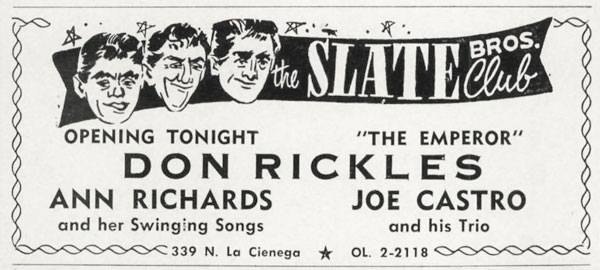
Castro was also a part of the recording of June Christy’s Ballads for Night People on August 27 and September 10.[•] On September 17, he was included in the recording of the soundtrack[•] for a documentary[•] produced by Lester Novros and written by poet Thomas McGrath, A Building is Many Buildings. The music was composed by Bob Cooper and performed by Howard Rumsey's Lighthouse All Stars. The music was released on LP as Jazz Structures.[•] On September 18 there was a recording date with Teddy Edwards and Dick Bock, that could be the Gloria Smith single Gee Baby Ain't I Good to You b/w I'll Be Over After While.[•]
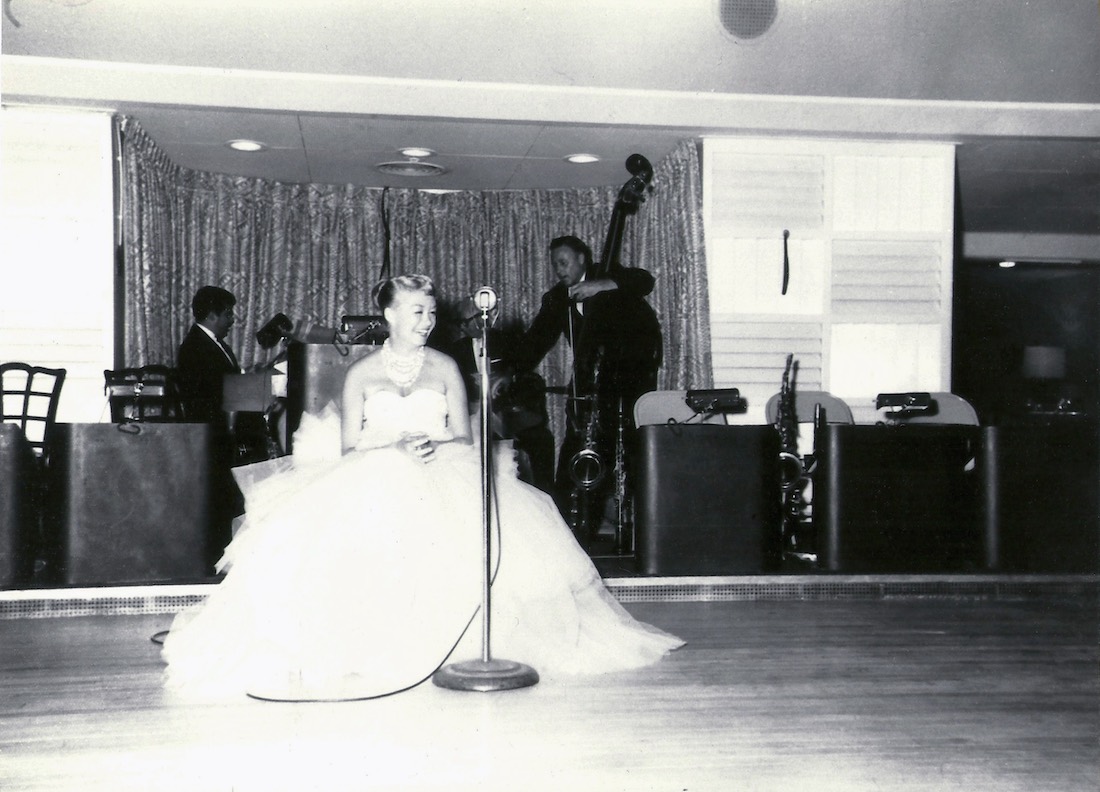
Castro’s work with Christy continued and he was added to a tour with Stan Kenton that left Los Angeles after two days' rehearsal on September 26 to Murray, Kentucky, for the first concert of the Road Show tour, at Murray State College Auditorium Here. The tour lasted until November 4 at Boston Symphony Hall. Castro was back in LA on November 12. During the tour a double album has been produced, Road Show Stan Kenton and His Orchestra June Christy The Four Freshmen.[•]
Castro spent the rest of the year in Las Vegas, at the Flamingo Hotel with The Kirby Stone Four.[•]
Castro: This guy was sort of managing me, George Greif, who was also managing the Kirby Stone group. So he talked me into helping them, playing with his band, to help back him up at the Hotel Flamingo. So I took it. So I went to Las Vegas again, and, also I went back on Monday to do the Steve Allen Show with June Christy.[•] I was doing the Kirby Stone group thing.
Castro spent the holidays with his family in Pittsburg.
This was a busy period for Castro as he shuttled between live performances and recording gigs. At the end of January there were three final Stan Kenton (Road) Shows[•] before the production disbanded.[•] In Las Vegas, Joe led a trio at the Sahara Hotel alongside performances by comedian Don Rickles.[•]
Castro: When I had been working at the Slate Brothers, of course, Don Rickles had heard me and I met him and all that. After I left, he had his manager, at that time it was an old fellow named Willy Weber, [he] called me at Falcon Lair, says: “By the way, hello Joe. Listen.... Don wants you to go to Las Vegas with him. It’s his first time there at the Sahara Hotel.” I said, “Yeah?” So I’m thinking to myself, “What am I going to do with him?” Because when I was at the Slate Brothers, Henry Slate [one of the owners] was an actor, also, he used to do the opening bits with him. I did nothing, just that he made fun of us. We played for Ann Richards or somebody, you know? So I told Willy, “I’ll tell you Willy, I want so much…." I told him a price, a lot of hundreds, you know, and also I want billing over everyone, except under Don, you know, and all the TV things. I want my name, that I’m also there with Don. Also, I want to pick two musicians, I want to pick them. I want to do two opening numbers before we even open on his time. Oh, I just went on and on.... I figure he’s going to turn me down, “What am I going to do with him?” I didn’t want to go to Las Vegas, anyway. He said, “Well, we’ll get back to you later this afternoon by one o’clock.” God he called back in five minutes, “You are on, you got it.” He wanted me that bad. Years later, I asked Don, I bumped into him, and asked him why he went for it? He says, “Because I liked your laugh, it made me feel comfortable my first time there.” That was the beginning of his 30 year run of concerts at the Sahara. And I picked Larry McKenna, great little jazz drummer from Reno that I knew, or he was living here [Las Vegas] then, and he moved to Reno, and Ralph Enriquez, a Filipino bass player. So Larry McKenna became the Nazi youth leader, Ralph Enriquez became the Jap, and I still was the wetback, but then he would do the opening numbers with me. I stayed on Cincinnati Boulevard, or Street, [Avenue] what they called them then. As a matter of fact, where Sahara [Avenue] was everything was San Francisco [Avenue], this was Cincinnati I stayed there. In fact, I got an apartment for Doris, who came up and Hannah Veary, one of her friends from Hawaii. I guess she was visiting, she was staying at Falcon Lair with her. They came up for the weekend. She was delighted. She could walk to the casino and watch all this and nobody would try to take pictures of her, nobody even knew her. I used to walk there. Midnight was the first show it was really weird, surreal. We stayed up until noon or one o’clock. I had breakfast at eleven o’clock at night and then go do the gig with Don Rickles....
During the Vegas gig, Castro was going back and forth every Monday to Los Angeles to rehearse and record…[•]
Castro: During this date with Don Rickles, I was also getting prepared to do half the charts for a quartet for June Christy called Cool School. I see that the arrangements that I did, you know, Magic Window, Looking for a Little Boy, Small Fry, Swinging on a Star, Scarlet Ribbons.... Well.... Ralph Enriquez, that’s another reason I mentioned him, he copied the parts for me, so I’d be with Don Rickles at the Sahara with this jazz trio opening for this comedian then on the day off I’d fly in, two Mondays in a row, to record Cool School with June Christy. We used Leroy Vinnegar, which was my suggestion, which Cooper had other people in mind. I had been working with Leroy. I had to rehearse him ‘cause he couldn’t read that well on the spot and he even asked for extra money for the date. I said, “Why don’t you give me some extra for rehearsing you?” We were just joking, blah, blah.... I gave him 50 dollars extra. He did a great job and he gave June another sound to sing against that was good for her. He had a great sound for accompaniment. We did the things for Capitol Records then we went back and I see Kirby Stone opened, but I was not with him, but I wrote a chaser for him....
(Castro looking at his diary) “Call Wynton Kelly.” He was at the [Hotel] Watkins. We had a party that night [March 2, 1960] with Leroy Vinnegar, Paul Chambers, Ed Tirella, Ron Jefferson, Greta Peck, who was Gregory Peck’s first wife, Miles Davis,[•] I guess he was with Teddy. He came to Falcon Lair. I asked him to leave. I gave him a bottle. He liked me, finally, not that he didn’t like me all along, but he just didn’t know me. He was always there with people, which I don’t blame him for....
and then, he was on a double bill at the Regency[•] on La Cienega alongside Slim Gaillard.
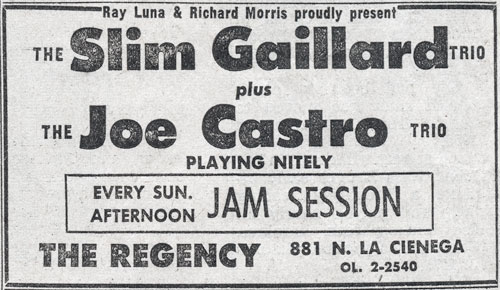
(James Castro Collection)
There was a bit of press concerned with Castro’s musical output of the time, too. The March 17, 1960 issue of Down Beat had an Ira Gitler review of a split LP featuring Sonny Rollins and Teddy Edwards[•] that mentioned Castro:
The session at Falcon's Lair (Doris Duke's home in Beverly Hills) sounds more like a last blowing rehearsal, prior to opening at a club, than playing for kicks in front of an audience. Castro seems to have improved over his first Atlantic outing of a few years ago, but he is still self-conscious and an employer of some corny licks dedicated to engender a real “jazz” feeling. Edwards, although swinging, is pretty shallow. He doesn't do any stretching out on the changes, and a pedestrian performance results, on that could be the work of a dozen faceless tenor men. I'm sure he can play with more inspiration than this. Crediting Edwards with paving the way “more than any other saxophonist” for the style than Rollins now employs [Leonard Feather producer’s notes] seems hyperbolic. The best thing from Falcon's Lair is the duo of Vinnegar and Higgins, but these two tracks bring down the over-all rating of the album.[•]
Joe Goldberg in Jazz Review,[•] does not seems to have listened to the same record:
Teddy Edwards’ two pieces are a revelation. His is straightforward tenor playing, with the kind of head-on swing typical of late forties bop that can topple over into Jack McVea style if the musician is not too careful. But Edwards eases around that pitfall with no trouble at all, playing melodies of simple, abrupt charm, closely allied to good harmonic ideas. These remarks all apply to Billie’s Bounce, and listening to Foggy Day immediately afterwards is startling. Just as he found the proper approach to the first tune, Edwards does the same for the second, employing a light, airy delicacy that would seem to be outside the realm of the man who played the first solo, except that the swing and guts are still there. Obviously, Edwards is a man who, with his other virtues, can apply himself to a specific tune, giving it exactly what it needs. An impressive recording that demands another.
Groove Funk Soul[•] was greeted by lukewarm reviews, including this two star effort by Barbara J. Gardner for Down Beat:
Another lovely little piano date with friends. Adding the broad, boisterous tenor of Teddy Edwards to the trio was a neat trick, but it doesn't work. Castro still remains a lyrical mood pianist and when he can achieve the unadorned simplicity and suspense that is exhibited on That's All, one can wonder why the hue and cry for Groove Funk Soul. Edwards Play Me the Blues almost makes it, but then comes this seasick feeling of rocking and rolling. It would be incorrect to suggest that Edwards has a definite tone quality. He has two. One is deep, throaty, and gutty, as on Play Me the Blues. The other is shallow and thin, almost without emotion. This tone pieces through Yesterdays. Throughout them both run the heavy drag toward rhythm and blues. Actually, without Edwards, the trio would sound like any other pretty mood date. Conversely, with another rhythm section Edwards perhaps would produce another of those rollicking dates critics pan and the public buys. Truthfully, the name also threw me. But Castro notwithstanding, there is not much jazz revolution to take to the hills about here.[•]
There was a more enthusiastic review, earlier, by Wilder Hobson:
In Joe Castro of Los Angeles we have a pianist who blends the most solid jazz spirit with a delicacy of feeling that finds particular expression in his sensitive use of changing dynamics. I have never been able to understand why so many jazz pianists operate for the most part on one dynamic level--a whole great musical resource is thus thrown away--and the tribe would do well to consider Castro's procedure. With Teddy Edwards, tenor sax, Leroy Vinnegar, bass, and Billy Higgins, drums, he offers Edwards’s especially lovely Play Me the Blues--more than nine minutes of rhythmic trance--and one of Castro’s own compositions is summed up by its title in which, with, I suspect, a certain tired irony, he has telescoped three words which have made so much recent writing about jazz difficult to contemplate: ‘Groove Funk Soul.’ As Louis Armstrong said in another connection, those who have to ask what they mean will probably have no way of discovering. In any event, the meaning is well illustrated by Castro.[•]
In April, Castro also managed to fit in a concert[•] and recording time[•] with June Christy, along with jamming on a Sunday afternoon with Dexter Gordon and Jack Sheldon[•] and coaching actors Darryl Hickman and Jane Withers.
And at the end of the Regency engagement, Castro had rehearsals with Bob Bertaux and Gene Estes,[•] with Anita O’Day[•] for the Anita and Billy May Swing album[•] and then with June Christy[•] for a week at the Crescendo.[•]
The three days prior to his thirteen week engagement at the Village West[•] with Teddy Edwards,[•] Castro was at Radio Recorders with Anita O’Day and Billy May.[•]

(James Castro Collection)

After a Saturday afternoon appearance at Hal Lederman's second annual Los Angeles jazz festival at the Hollywood Bowl on June 18, Leonard Feather invited him to participate on his first show “A Look at West Coast Jazz.”[•] After a short and happy break in NY, likely at the end of July[•] according to the columnists,[•] Castro was back in LA. The second recording featuring the working quartet, together again (for the last time?) to complete an album of Teddy Edwards’s for Pacific Jazz Records. Sunset Eyes was recorded on August 16,[•] and on the 17th,[•] for Teddy's Ready, to be released by Contemporary.[•] The following Sunday afternoon the Quartet “furnished” the music at the Memory Lane.[•]
After a three week trip with stops in New York, Chicago, South Dakota, Duke Farms, Somerville, Rough Point, and Newport,[•] Castro was back in Los Angeles. The Quartet with Maurice Miller on drums was announced[•] for the reopening of The Jazz Cellar[•] in San Francisco, but it turned out to be the local Chuck Carter who got the gig.[•]
The four week stay at the Jazz Cellar presented an opportunity to give an interview to Russ Wilson of the Oakland Tribune. It was printed with the title “Joe Castro, Leroy Vinnegar Set for Long Stay in Paris:”
Pianist Joe Castro, whose consuming interest in jazz music began during his school days in Pittsburg, Calif., and bassist Leroy Vinnegar will fly to Paris this week to join drummer Kenny Clarke for an extended engagement at the Blue Note, one of the French capital’s top jazz clubs. The trio will operate as the house band and also the rhythm section for guest stars among whom, it is to be assumed, will be such American expatriates as Stan Getz, Don Byas, Lucky Thompson and Bill Coleman as well as European jazzmen. Plans are, Castro said, that some of the combos will record for Barclay Records, the première French company, and for Atlantic and Contemporary, two of the foremost American jazz labels. “It’s a very inspiring outlook,” he said. “Not only is there a great and increasing interest in modern jazz in Paris, but the entire European scene is expanding.” With the passing of Sidney Bechet a few months ago, Clarke is probably the best known American jazz musician living in Europe. A veteran whose roots go back to the Swing Era, Clarke was one of the guiding lights in the development of bop and later was a founding member of the Modern Jazz Quartet. He has lived in Paris since 1955 [1956]. [•] Vinnegar, one of the truly great rhythm bassists, is looking forward to the trip with undisguised elation. A native of Indianapolis but a resident of Los Angeles for the last six years, this will be his first journey overseas. “I’m really thrilled by it,” Vinnegar declared with a happy grin, “and it’s still hard to believe it’s true.” We were conversing at the Jazz Cellar, where Vinnegar and Castro just completed a month’s engagement with the Teddy Edwards Quartet and where the Ben Webster Quartet and blues singer Jimmy Witherpoon, formerly of Vallejo, now are holding forth.[•]
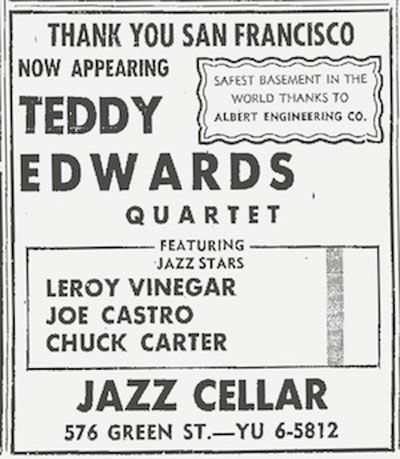
This information would be included in publications such as Variety,[•] and Down Beat:
Pianist Joe Castro and bassist Leroy Vinnegar, lately with the Teddy Edwards Quartet at the now-shuttered Village West, have betaken themselves to Europe. First stop is the Blue Note, in Paris, where they will work with expatriate-drummer Kenny Clarke, to be followed by a stint with Stan Getz. Duration of the trip? “Indefinitely,” says Castro.[•]
Leaving from San Francisco to Los Angeles and then Los Angeles to New York, where Castro celebrated Doris Duke’s birthday with Nesuhi Ertegun, Castro flew to Paris.[•]
We have no information about the motivation behind their departure, nor that which caused a return. The Three Bosses (Bud Powell, Pierre Michelot, and Kenny Clarke) were in residence at the Blue Note in Paris, beginning in December 1959 and remaining consistently until the end of February or early March 1961.[•]
The group never worked the Blue Note as they remained at Mars Club.[•] The big jazz happening in Paris at that time was the filming of Paris Blues. Castro spent a lot of time with friends Aaron Bridgers, who was living and working in Paris,[•] and Billy Strayhorn, who came to work with Duke Ellington on the film’s music. Louis Armstrong was also there to appear in the film.[•]
In Castro’s diary, all of Castro’s contacts, people and places, important to an American jazz musician in Paris could be found: Mezz Mezzrow, Nancy Holloway, Art Simmons, Kenny Clarke, Herman Leonard, Nicole Barclay and places like Chez Nancy Holloway, Chez Gabby,[•] Hôtel la Louisiane, Blue Note, Club Saint-Germain, Le Chat qui pêche, Les Trois Mailletz, and Hôtel de la Trémoille,[•] where Duke Ellington, Billy Strayhorn, and Louis Armstrong were staying during the making of Paris Blues and the scene of some interesting meetings, including one with Leroy Vinnegar Billy Strayhorn, and René Leibowitz.[•]
His first rendez-vous was on Wednesday, November 30 to attend a party at the Boulogne Studios for an “apéritif en musique avec Duke Ellington.” The date of Ellington’s arrival in Paris has remained uncertain.[•] This party seemed to have been cancelled and replaced by a “Cocktail reception” organized by the producers of Paris Blues on Tuesday, December 13 at Terrasse Martini.[•]
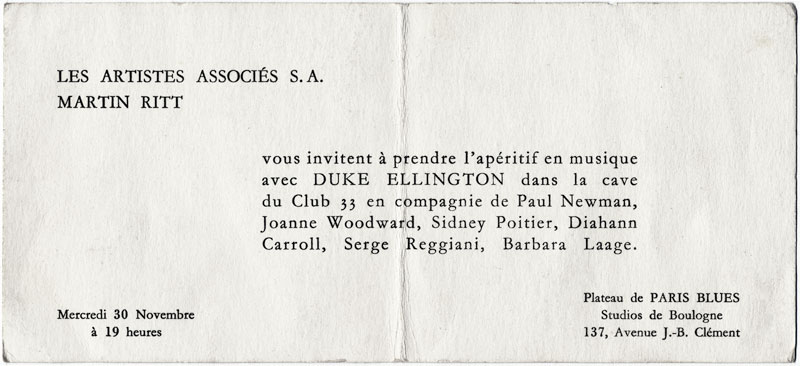
Joe Castro, Leroy Vinnegar, and Charles Bellonzi began rehearsing at the Mars Club[•] on Tuesday, December 6,[•] for the Thursday, December 15 opening, which included a Louis Armstrong visit where he sang I’m Confessin’ and On the Sunny Side of the Street.[•]
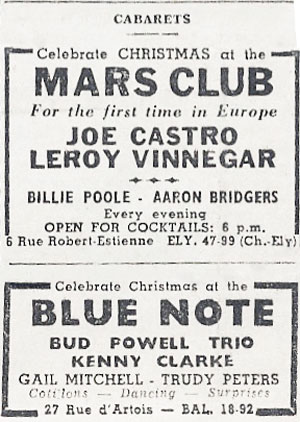
(James Castro Collection)
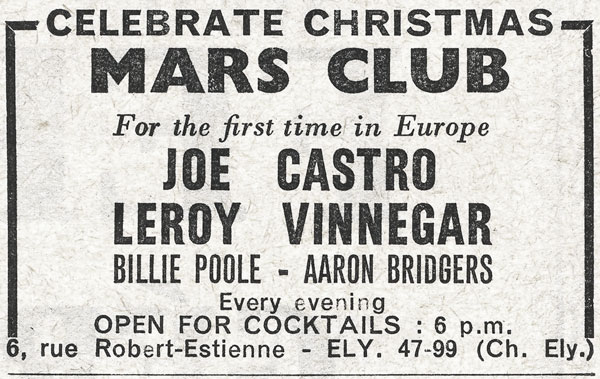
(James Castro Collection)
Musicians recorded at Mars Club, Paris:
At the beginning of January, Castro sent some information to Russ Wilson that was included in his article about jazz abroad in Oakland Tribune:
Paris, long a hotbed of traditional jazz, is becoming more and more receptive to the modern sounds. Pianist Joe Castro, of Pittsburg, Calif. and bassist Leroy Vinnegar, who are playing at the Mars Club with a young French drummer Charles Bel[l]onzi, have been asked to fill a spring concert and festival schedule. Shortly after the trio opened, Louis Armstrong fell by and sang with the group. Castro attended a recording session at which Duke Ellington and Billy Strayhorn conducted the music they have written for movie Paris Blues and reports it is extraordinary. Castro also says that pianist Bud Powell, whose trio is in Paris, is playing magnificently.[•]
Castro returned to the United States on January 20th and immediately traveled from New York to Los Angeles to Honolulu.[•]
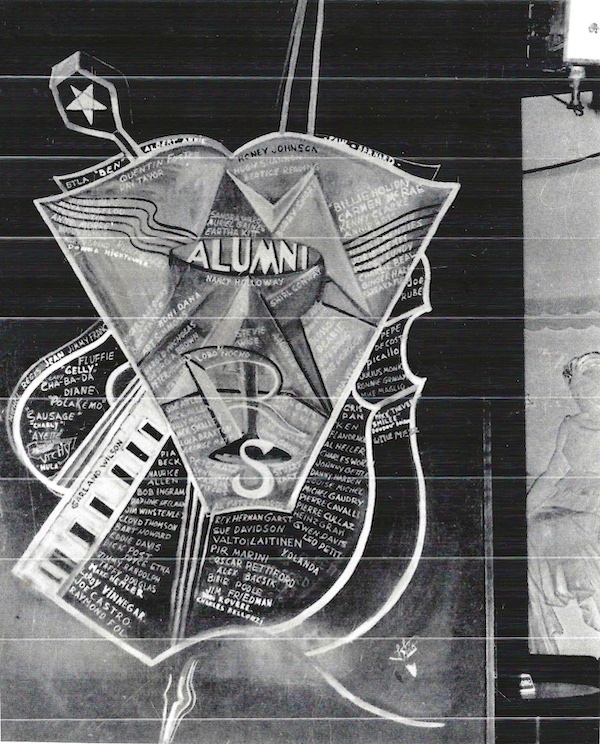
(Sally Shanley Dorough - Claude Carrière Collection)
